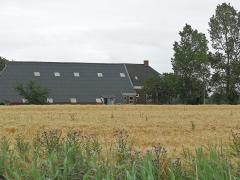From forest to waste: assessment of the Brazilian soybean chain, using nitrogen as a marker
With economic growth, urbanization and changing diets, world demand for plant-derived oils and their derivates is soaring. Oils are used inter alia in the food, feed and cosmetics industry, and increasingly as a biofuel. Soybean is one of the major booming oil crops. In addition to oil, it offers a very valuable by-product, i.e. protein-rich soy meal, a raw material for animal feed. Increasing global demand for animal products puts pressure on arable land, given the fact that at least two but often more kilograms of grains are needed to produce one kilogram of meat, i.e. the so-called feed meat ratio, and that an array of environmental problems is looming due to the expanding livestock sector.
Abstract
Soybean (Glycine max) is a booming crop in Brazil. In 2004, the export value was equivalent to 10 billion US $, covering over 10% of total Brazilian exports. Three-quarters of total production leaves the country, mainly to China and the European Union (EU). Soybean cultivation in Brazil is expected to expand further in the coming decades, mainly responding to growing demand in Asia. This will, amongst others, entail transport of vast amounts of nutrients, triggering the need to better study the entire soybean chain.
The objective of this study was to estimate and calculate the soybean chain, including five phases: conversion, cultivation, transport and processing, consumption and waste disposal, starting in Brazil, and ending in Brazil, China and EU, using nitrogen (N) as a marker, and looking at three time periods (1993–1995; 1998–2000; 2003–2005).
The study revealed that conversion of forest and savanna to pasture and agricultural land entails N losses of 2000–6000 million kg year−1. Removal of N in soybean harvests went up from 1400 million to almost 3000 million kg year−1 between 1993–1995 and 2003–2005. These high values were offset by biological N fixation by soybean and increased adoption of conservation agriculture. N balances in soybean-based agricultural systems became positive after about one decade in the period 2003–2005, thus reducing the soybean-associated global N cascade. Upon crushing, three-quarters of soybeans end up as high-protein soy meal, which is mainly fed to pigs and chickens. Nitrogen in meat, milk and eggs from soy meal-fed animals was estimated at around 20% of N in freshly crushed soy meal. More than half of the lost N can potentially be recycled, although mostly far away from the site of soybean production.
Authors
Specifications
- Publication title
- From forest to waste: assessment of the Brazilian soybean chain, using nitrogen as a marker
- Publication date
- 28 August 2008
- Publication type
- Publication
- Magazine
- Agriculture Ecosyst Environ 2008; 128(3):185-97
- Product number
- 92288




